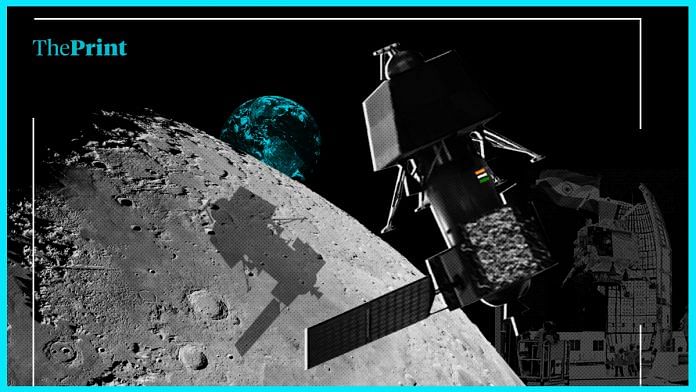ISRO Chandrayaan-2’s Vikram lander will land on moon early Saturday. What makes this mission historic is that India will be the first country to achieve a soft landing on the south pole of the moon. The mission’s objective is to explore and study the “extent of water molecule distribution” on the lunar surface.
ThePrint asks: Will the Chandrayan-2 moon landing be India’s biggest scientific achievement?
Like Vasco da Gama’s voyage, Chandrayaan-2, if successful, will have a special place in India’s space-faring history
 Sudip Bhattacharyya
Sudip Bhattacharyya
Associate Professor, Tata Institute of Fundamental Research
The moon landing of Chandrayaan-2’s Vikram lander will be a very special Indian technological achievement.
Managing the extremely complex navigation and control, achieving a low touch-down velocity, and landing safely avoiding all potential hazards will all be particularly challenging.
One may rightly ask why this landing is so special. After all, Chandrayaan-1 had already orbited the moon. Moreover, the Chandrayaan missions are no isolated missions. They have been built on the legacy and experience of many space missions undertaken by the ISRO. Besides, this is only the beginning of Indian space-faring, and many more momentous achievements are likely in the waiting.
In an endeavour to explain the importance of this first Indian soft landing on the moon, I would argue that the current scale of space-faring could be compared with the beginning of large-scale sea-faring back in the 15th century. Towards the end of that century, the success of Vasco da Gama’s voyage was only a natural consequence of decades of aggressive sea exploration by the Portuguese. In fact, a few years before Vasco da Gama arrived at Calicut in India, his countryman Bartolomeu Dias had already gone around the southernmost tip of Africa, like Chandrayaan-1 preceded Chandrayaan-2.
The Portuguese had many achievements to their credit even after Vasco da Gama’s voyage – they essentially ruled the seas, from the Persian Gulf to the Strait of Malacca. But the success of Vasco da Gama has always been considered a key achievement. In a somewhat similar manner, if Chandrayaan-2 turns out to be successful, it will always have a special place in the history of Indian space exploration.
Chandrayaan-2’s moon landing not a new achievement as three countries have already got there

Dibyendu Nandi
Scientist, Indian Institute of Science Education and Research
An achievement in “science” involves a breakthrough in understanding a natural process or phenomenon, a new discovery or an observation, or an invention of a machine that allows us to achieve something new. In this context, landing a spacecraft on nthe moon is not a new achievement from the scientific perspective because the understanding of how to achieve this has existed for half-a-century now, and the task itself has been demonstrated by three other countries before.
Nevertheless, landing successfully on another astronomical body outside the Earth with no possibility of human-mediated guidance and corrections remains an incredibly hard technological challenge, and even the most advanced space agencies still confront failure. In this context, a successful landing on the moon will certainly be a big technological and engineering advancement for India, and possibly the biggest achievement for the country in the technology domain in the last few decades.
What comes next — the exploration of the moon by the lander Vikram and rover Pragyan — has the possibility of accomplishing some big scientific breakthroughs.
Also read: Chandrayaan-2 set to begin final descent — indigenous mission hours away from history
C.V. Raman & Meghnad Saha’s contributions are as important as Chandrayaan-2’s achievements
 Aniket Sule
Aniket Sule
Scientist, Homi Bhabha Centre for Science Education, TIFR, Mumbai
In India, we rarely work on scientific projects with end-to-end development. Chandrayaan-2 was conceptualised, developed and launched from India, and, in that sense, it is indeed the pinnacle of technological R&D in post-Independence India. The technologies that we started developing for Chandrayaan-1 and then the Mangalyaan mission are all coming in handy for Chandrayaan-2.
In 20th century pre-Independence India, several scientists had made seminal contributions in the field of space exploration. For example, C.V. Raman worked on spectroscopy and Meghnad Saha on solar atmosphere. These contributions must be recognised when we talk about the success of Chandrayaan-2.
In India, several research groups are working on cutting-edge research, which includes work on ultra-cold atoms, genetics and string theory. We have been participating in international mega science projects too. However, in these cases, India’s role is limited because our research is only a part of a bigger research project.
That’s why a project like Chandrayaan-2 is important because India can take credit for end-to-end development.
Choosing an unexplored area like the south pole of the moon for landing shows ISRO’s confidence
 Rajeswari Pillai Rajagopalan
Rajeswari Pillai Rajagopalan
Head of the Nuclear and Space Policy Initiative, at Observer Research Foundation
Independent India has had a number of scientific achievements, including the Chandrayaan-1 mission, and it will be difficult to rank them because they are all equally impressive in the context of India’s development.
The Indian space programme itself has had impressive achievements like the successful launch of the SLV-3 in 1980. The recent anti-satellite (ASAT) test is also a significant achievement in the science and technology realm. India has had significant achievements in the nuclear realm too – the nuclear test in 1974 and the setting up of the fast-breeder test reactor. The Chandrayaan-2’s success will definitely earn the mission a place in this group of scientific and technological achievements.
Any landing on the lunar surface or indeed on any extra-terrestrial surface will be difficult, but landing on an unexplored area like the south pole of the moon much more so. It says a lot about the self-confidence of the ISRO and its leaders that they chose the south pole of the moon for their first attempt in extra-terrestrial soft landing. While we can all hope for Chandrayaan-2’s success, what has been achieved so far is remarkable for a country like India.
Also read: As we await Chandrayaan-2 landing, here’s how Vikram Sarabhai hailed Apollo-11 fifty yrs ago
Calling Chandrayaan-2 India’s biggest feat would mean writing off contributions of other science branches
 Mohana Basu
Mohana Basu
Special Correspondent, ThePrint
Calling the Chandrayaan-2 mission India’s biggest scientific achievement would be to limit the merits of the country’s entire scientific community to one grand spectacle. While there is no doubt that Chandrayaan-2’s successful landing on the moon would be a significant milestone in India’s space programme, dubbing it the ‘biggest’ achievement would mean writing off the contributions of the other branches of science.
Our engagement with science is an ongoing journey with each small discovery adding to a vast body of knowledge and innovations. The technical know-how gained during the decades of research for the Chandrayaan missions will percolate into fields like medical science. These applications will have bigger implications in our everyday lives.
The Indian scientific community has contributed in innumerable ways towards the progress of science, but not each discovery gets the same magnitude of fanfare that space missions attract.
The Chandrayaan-2 moon landing is a huge moment for India and deserves the celebration, but let us also remember that scientific achievements are not measured only by what successfully flies into space.
We need to appreciate the life-changing innovations happening right here on earth and understand that the Chandrayaan-2 mission is part of a much bigger journey that transcends national boundaries and even time.
By Mohana Basu




A proud moment for India and all members of the ISRO family. Everyone remembers Apollo XI as an American success, few would recall that Richard Nixon wad President, givng shape to JFK’s dream.